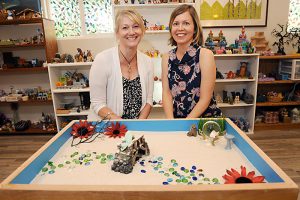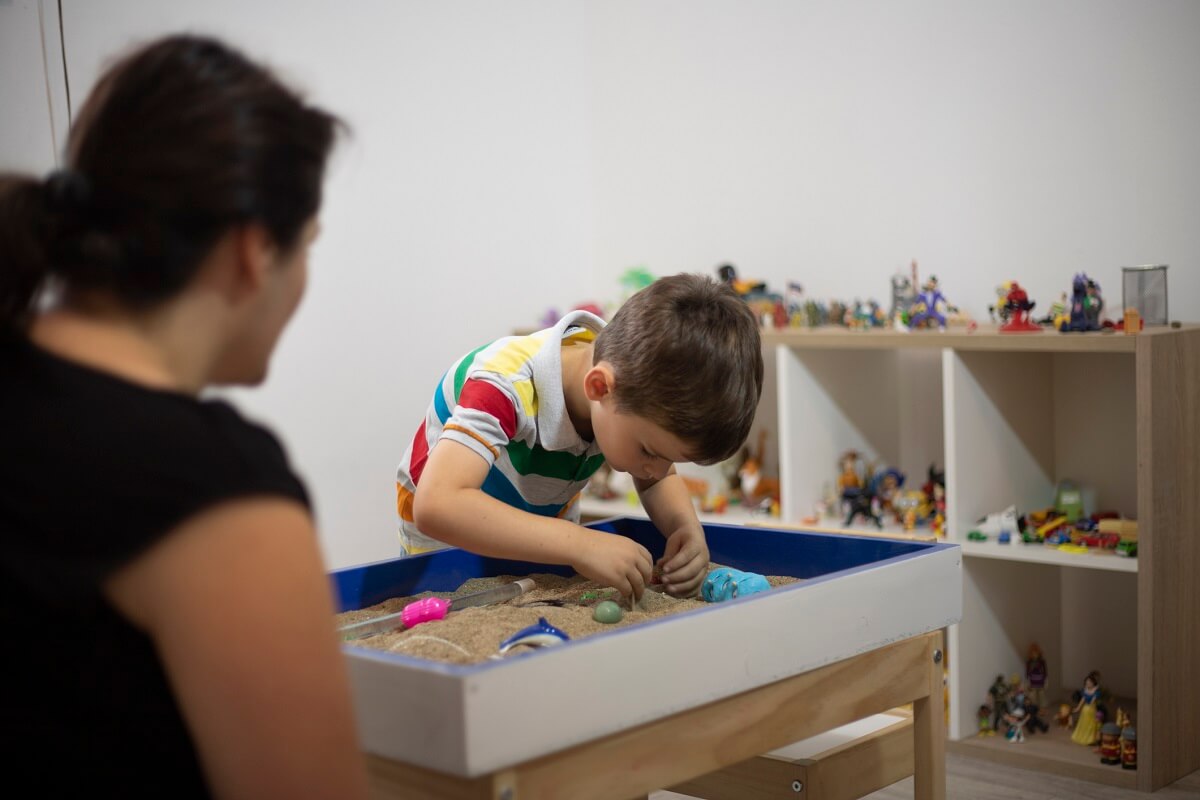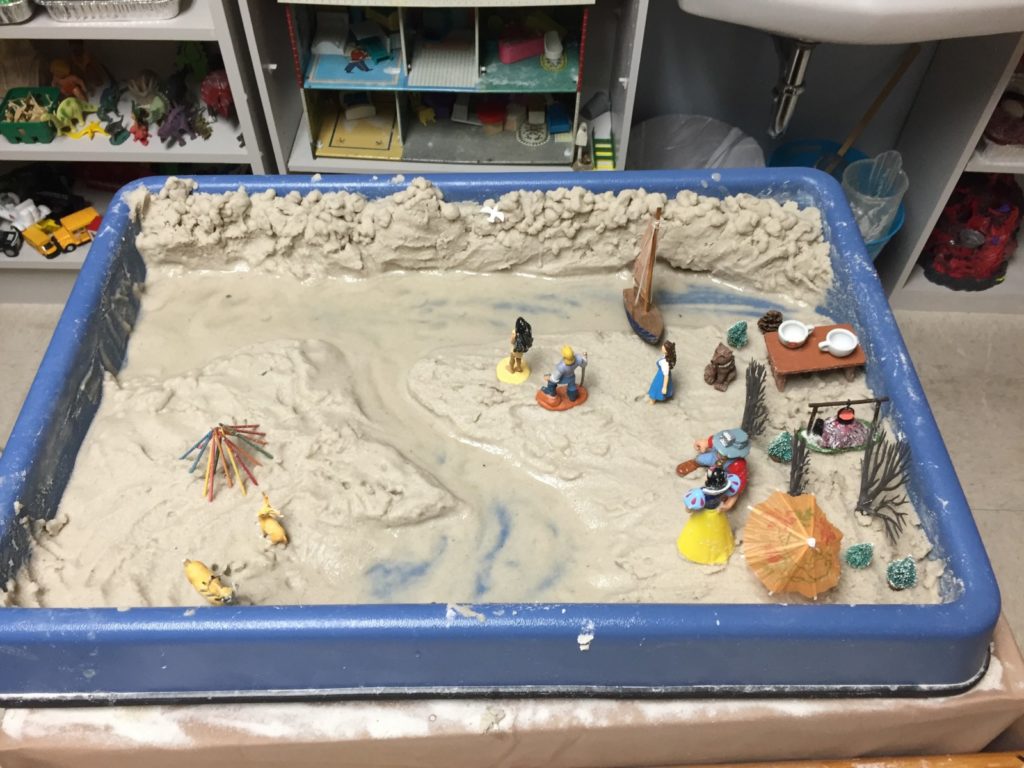If you’re looking for an effective and unique method of treating mental disorders, look no further than sand play therapy. This approach has been shown to be successful in helping people with a variety of issues, including anxiety, depression, and post-traumatic stress disorder. In this blog post, we will discuss what sandplay therapy is, how it works, and some of the benefits that have been associated with it.
Contents
What Is Sandplay Therapy?
 Sandplay therapy is a unique and effective method for treating mental disorders. It involves the use of miniature figurines and props to create a sandbox-like environment in which patients can express their thoughts and feelings. This type of therapy can be beneficial for people of all ages, and it has been shown to be especially effective in treating children and adolescents.
Sandplay therapy is a unique and effective method for treating mental disorders. It involves the use of miniature figurines and props to create a sandbox-like environment in which patients can express their thoughts and feelings. This type of therapy can be beneficial for people of all ages, and it has been shown to be especially effective in treating children and adolescents.
This type of therapy can help patients to explore their thoughts and feelings, and it can also provide them with a safe space in which they can express themselves freely. Sandplay therapy is often used in conjunction with other forms of treatment, such as counseling or medication.
Different Types of Sandplay Therapy

There are many types of sandplay therapy, and each one can be tailored to meet the specific needs of the patient. Some common types of sandplay therapy include:
Cognitive-Behavioral Play Therapy
This therapy is based on the idea that thoughts and behaviors are interconnected. It aims to help patients change their negative thoughts and behaviors, which can lead to a more positive self-image. Sometimes this type of therapy is used in conjunction with medication or counseling.
Depth-Oriented Play Therapy
This form of therapy focuses on the emotional and psychological depths of the patient. It helps patients to explore their feelings and unconscious thoughts, and it can also help them to resolve conflicts and trauma.
Expressive Arts Therapy
This type of therapy uses creative expression to promote healing. It can involve any type of art, such as painting, drawing, sculpting, or music. This type of therapy can be beneficial for people who have difficulty expressing themselves verbally.
Nature-Based Play Therapy
This type of therapy uses nature as a therapeutic tool. Patients can engage in activities such as hiking, camping, birdwatching, or gardening. Nature-based play therapy can help patients to connect with their natural environment and to develop a deeper understanding of themselves.
Depth Psychology Play Therapy
This type of therapy is based on the theories of Sigmund Freud and Carl Jung. It focuses on the unconscious mind, and it seeks to uncover hidden emotions and memories. This type of therapy can be helpful for people who are struggling with unresolved conflicts or trauma.
Group Sandplay Therapy
Group sandplay therapy involves the use of a sandbox where a group of people can work together to create a therapeutic environment. This type of therapy can be helpful for people who are struggling with social anxiety or isolation.
Working of Sandplay Therapy
 When a person participates in sandplay therapy, they are typically seated across from their therapist. They are then given a set of miniature figurines and props to use in their sandbox. Patients are free to create whatever scenes or stories they like with these objects.
When a person participates in sandplay therapy, they are typically seated across from their therapist. They are then given a set of miniature figurines and props to use in their sandbox. Patients are free to create whatever scenes or stories they like with these objects.
The therapist will often encourage patients to share the meanings that they associate with different objects in their sandbox. This can be a valuable way for patients to explore their thoughts and feelings, and it can also help them to develop a better understanding of themselves.
Sandplay therapy can be an extremely effective tool for helping people to deal with mental disorders. It allows patients to express themselves freely and openly, which can be beneficial for both their mental and emotional health. If you are struggling with a mental disorder, sandplay therapy may be the right treatment for you. Contact your therapist today to find out more about this unique form of therapy.
This therapy works by giving the patient miniature figurines and props to use in their sandbox. Patients are free to create whatever scenes or stories they like with these objects. The therapist will often encourage patients to share the meanings that they associate with different objects in their sandbox. This can be a valuable way for patients to explore their thoughts and feelings, and it can also help them to develop a better understanding of themselves.
What Does Sandplay Therapy Treat?
There are many mental disorders that sandplay therapy can treat. These include, but are not limited to:
Anxiety
 Sandplay therapy always helps to release bottled-up emotions and it is extremely helpful for anxiety. Sometimes, people might have a fear of sandplay or they may not know how to deal with their emotions. In this case, the therapist will work together with them until they feel safe and secure in the environment.
Sandplay therapy always helps to release bottled-up emotions and it is extremely helpful for anxiety. Sometimes, people might have a fear of sandplay or they may not know how to deal with their emotions. In this case, the therapist will work together with them until they feel safe and secure in the environment.
Depression
When people are depressed, they tend to withdraw from the world and lose interest in activities that they once enjoyed. Sandplay therapy can help these individuals to reconnect with their inner child and rediscover the joys of life.
PTSD
 People who suffer from PTSD often have difficulty dealing with their thoughts and feelings. They may also find it difficult to trust others. Sandplay therapy can provide these individuals with a safe space where they can express themselves freely without feeling judged or ridiculed.
People who suffer from PTSD often have difficulty dealing with their thoughts and feelings. They may also find it difficult to trust others. Sandplay therapy can provide these individuals with a safe space where they can express themselves freely without feeling judged or ridiculed.
ADHD
Children and adolescents who suffer from ADHD often have trouble focusing and paying attention. Sandplay therapy can help these individuals to focus on the task at hand and improve their ability to concentrate.
Autism
People with autism often have difficulty communicating with others and understanding social cues. Sandplay therapy can help them to learn how to interact with others in a healthy and safe way.
Bipolar Disorder
 People who suffer from bipolar disorder often experience extreme mood swings that can interfere with their daily life. Sandplay therapy can help these individuals to regulate their emotions and stay calm during difficult situations.
People who suffer from bipolar disorder often experience extreme mood swings that can interfere with their daily life. Sandplay therapy can help these individuals to regulate their emotions and stay calm during difficult situations.
Eating Disorders
People who suffer from eating disorders often have an unhealthy relationship with food. They may see food as a means of gaining control over their lives. Sandplay therapy can help these individuals to develop a healthy relationship with food and learn to trust their own intuition.
Schizophrenia
People who suffer from schizophrenia often have difficulty distinguishing between reality and fantasy. They may also experience hallucinations or delusions. Sandplay therapy can help these individuals to understand the difference between reality and fantasy, and it can also help them to cope with their hallucinations and delusions.
Agression

People who are aggressive often have a lot of anger and hostility bottled up inside them. Sandplay therapy can help these individuals to express their anger in a healthy and safe way. It can also help them to develop better relationships with others.
Techniques of Sandplay Therapy

There are many different techniques that can be used in sandplay therapy. Here are a few of the most common techniques:
Free Association
This technique involves allowing the patient to explore their thoughts and feelings without any restrictions. The therapist will allow the patient to talk about whatever they want, and they will not judge or criticize them. This can be a safe space for patients to express themselves freely and openly.
Storytelling
This technique involves having the patient create a story with the miniature figurines in their sandbox. The therapist will often ask questions about the story, and they will encourage the patient to share their thoughts and feelings about it. This can be a valuable way for patients to explore their innermost thoughts and feelings.
Role Play
This technique involves having the patient take on different roles in their sandbox. They may pretend to be a character from their favorite book or movie, or they may create a new character altogether. This can be a fun and creative way for patients to explore their emotions and feelings.
Toy phones
This technique involves giving the patient a toy phone so that they can talk to the miniature figurines in their sandbox. The therapist will often ask them questions about their conversations, and they will encourage the patient to share their thoughts and feelings about it. This can be a valuable way for patients to explore their innermost thoughts and feelings.
Sessions of Sandplay Therapy
These sessions involve the use of small figures and objects that represent aspects of the person’s life, such as animals, people, plants, buildings, and landscapes. The therapist will ask the client to create a scene with these objects that represent how they feel or what is going on in their life. This can be done either verbally or through artwork.
There are approximately 3-4 sessions of sandplay therapy each week, and they last around 50 minutes. These sessions last for about 16 weeks, and the therapist will meet with the client individually for each session.
Benefits of Sandplay Therapy

There are many benefits of sandplay therapy, including:
Helps To Build Self-Awareness
This therapy can help people to become more aware of their feelings and emotions, which can lead to a better understanding of themselves. Sometimes, people are not even aware of what they are feeling, and this therapy can help to surface these hidden emotions.
Helps People Address Trauma
Traumatic events can often be difficult for people to talk about, but sandplay therapy can provide a safe space for them to do so. This type of therapy can help people to process the trauma they have experienced and work through it.
Helps To Treat Variety of Mental Disorders
Sandplay therapy is an effective treatment for a variety of mental disorders, including anxiety, depression, PTSD, and ADHD. It is a versatile tool that can be tailored to meet the needs of each individual client. This therapy can help to provide relief from the symptoms of these disorders.
Helps To Build Relationships
Sandplay therapy can help to build relationships by providing a space for people to share their thoughts and feelings with others. This type of therapy can create a sense of trust and safety, which can be helpful in developing meaningful relationships. It also allows people to connect with others who may be going through similar experiences.
Build Intimacy And Trust
Intimacy and trust can be difficult to achieve, but sandplay therapy can help to foster these qualities. This type of therapy provides a safe space for people to share their thoughts and feelings with others, which can lead to a deeper level of intimacy and trust. It can also help people to connect with others who may be going through similar experiences.
Makes Therapy Fun
This type of therapy can be fun and enjoyable, which can make it easier for people to open up and talk about their feelings. The use of toys and objects can help to lighten the mood and create a more relaxed atmosphere. This can be beneficial for those who are struggling with mental health issues.
Limitations of Sandplay Therapy

There can be many limitations of sandplay therapy, including:
Difficulty To Express Themselves Verbally
Some people find it difficult to express themselves verbally, and this type of therapy may not be suitable for them. They may prefer to communicate through artwork instead. It also takes time for people to feel comfortable with this type of therapy and to open up about their feelings.
May Not Be Suitable For All Mental Disorders
Sandplay therapy may not be suitable for all mental disorders. It is a versatile tool that can be tailored to meet the needs of each individual client, but it is not effective for every disorder. It also takes time for people to feel comfortable with this type of therapy and to open up about their feelings.
Requires Trust And Intimacy
This type of therapy requires trust and intimacy, which may not be possible for some people. It can be difficult to build these qualities in a therapeutic setting, but it is essential for sandplay therapy to be effective. This also takes time for people to feel comfortable with this type of therapy and to open up about their feelings.
May Be Too Playful For Some
Some people may find the playfulness of sandplay therapy to be inappropriate or overwhelming. It is important for therapists to be aware of how different clients may react to this type of therapy and adjust accordingly. This also takes time for people to feel comfortable with this type of therapy and to open up about their feelings.
Can Be Expensive
This therapy maybe is expensive for some people, depending on their location. It is important for therapists to be aware of the cost and make sure that clients are informed of any associated fees. This also takes time for people to feel comfortable with this type of therapy and to open up about their feelings.
May Be Time-Consuming
This type of therapy may be time-consuming, which can be a challenge for some people. It is important for therapists to be aware of the amount of time that is required for this type of therapy and to make sure that clients are informed of any associated fees. This also takes time for people to feel comfortable with this type of therapy and to open up about their feelings.
Conclusion
In conclusion, sandplay therapy is a unique and effective method for treating mental disorders. It can be fun and enjoyable, which can make it easier for people to open up and talk about their feelings. The use of toys and objects can help to lighten the mood and create a more relaxed atmosphere. This can be beneficial for those who are struggling with mental health issues. However, there are some limitations to this type of therapy, including the fact that it may be difficult for some people to express themselves verbally. It also takes time for people to feel comfortable with this type of therapy and to open up about their feelings.
A Word From Therapy Mantra
Your mental health — your psychological, emotional, and social well-being — has an impact on every aspect of your life. Positive mental health essentially allows you to effectively deal with life’s everyday challenges.
Also, at Therapy Care, we have a team of therapists who provide affordable online therapy to assist you with issues such as depression, anxiety, stress, relationship, OCD, LGBTQ, and PTSD. You can take our mental health test. You can also book a free therapy or download our free Android or iOS app.


